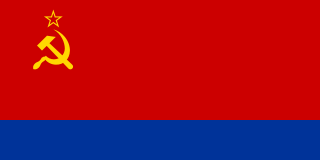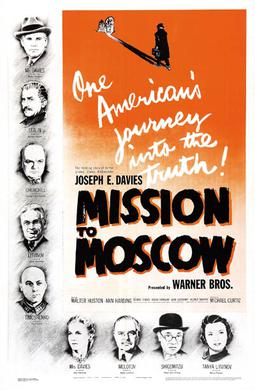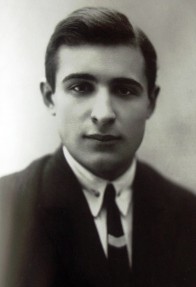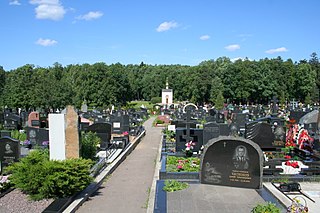A list of films produced in the Soviet Union in 1937 (see 1937 in film).
A list of films produced in the Soviet Union in 1937 (see 1937 in film).

The 1930s was a decade that began on January 1, 1930, and ended on December 31, 1939. In the United States, the Dust Bowl led to the nickname the "Dirty Thirties".

The State Flag of the Union of Soviet Socialist Republics, or simply the Soviet flag, was a red banner with two communist symbols displayed in the canton: a gold hammer and sickle topped off by a red five-point star bordered in gold. The flag's design and symbolism are derived from several sources, but emerged during the Russian Revolution. It has also come to serve as the standard symbol representing communism as a whole, recognized as such in international circles, even after the dissolution of the Soviet Union in 1991.

The Great Purge or the Great Terror, also known as the Year of '37 and the Yezhovshina, was Soviet General Secretary Joseph Stalin's campaign to solidify his power over the Communist Party of the Soviet Union and the state by eliminating his rivals by drastic use of imprisonment and execution. In particular, the purges were designed to remove the remaining influence of Leon Trotsky. They occurred from August 1936 to March 1938, with the most prominent feature being show trials of leading Bolshevik party members. However, a considerable proportion of the country's population was affected as well.

The Stakhanovite movement was a mass cultural movement of workers which originated in the Soviet Union, and encouraged socialist emulation and rationalization of workplace processes. The Stakhanovites (стаха́новцы) modeled themselves after Alexei Stakhanov, a coal miner, and took pride in their ability to produce more than was required by working harder and more efficiently, thus contributing to the common good and strengthening the socialist state. The movement began in the coal industry but later spread to many other industries in the Soviet Union. Initially popular, it eventually encountered resistance as the increased productivity led to increased demands on workers.

The Azerbaijan Soviet Socialist Republic, also referred to as the Azerbaijani Soviet Socialist Republic, Azerbaijan SSR, Azerbaijani SSR, AzSSR, Soviet Azerbaijan or simply Azerbaijan, was one of the constituent republics of the Soviet Union between 1922 and 1991. Created on 28 April 1920 when the Russian Soviet Federative Socialist Republic brought pro-Soviet figures to power in the region, the first two years of the Azerbaijani SSR were as an independent country until incorporation into the Transcausasian SFSR, along with the Armenian SSR and the Georgian SSR.

The history of the Soviet Union between 1927 and 1953 covers the period in Soviet history from the establishment of Stalinism through victory in the Second World War and down to the death of Joseph Stalin in 1953. Stalin sought to destroy his enemies while transforming Soviet society with central planning, in particular through the forced collectivization of agriculture and rapid development of heavy industry. Stalin consolidated his power within the party and the state and fostered an extensive cult of personality. Soviet secret-police and the mass-mobilization of the Communist Party served as Stalin's major tools in molding Soviet society. Stalin's methods in achieving his goals, which included party purges, ethnic cleansings, political repression of the general population, and forced collectivization, led to millions of deaths: in Gulag labor camps and during famine.

The culture of the Soviet Union passed through several stages during the country's 69-year existence. It was contributed to by people of various nationalities from every one of fifteen union republics, although the majority of the influence was made by the Russians. The Soviet state supported cultural institutions, but also carried out strict censorship.

Mission to Moscow is a 1943 propaganda film directed by Michael Curtiz, based on the 1941 book by the former U.S. ambassador to the Soviet Union, Joseph E. Davies.

People's Artist of the USSR, also sometimes translated as National Artist of the USSR, was an honorary title granted to artists of the Soviet Union. The term is confusingly used to translate two Russian language titles: Народный артист СССР, awarded in performing arts and Народный художник СССР, granted in some visual arts.

The Academy of Sciences of the Soviet Union was the highest scientific institution of the Soviet Union from 1925 to 1991. It united the country's leading scientists and was subordinated directly to the Council of Ministers of the Soviet Union.
These are lists of films produced in the Soviet Union between 1917 and 1991. Films are listed by year of release in alphabetical order on separate pages.

Alexander Arturovich Rou was a Soviet film director, and People's Artist of the RSFSR (1968). He directed a number of children's fantasy films, based mostly on Russian folklore, that were highly popular and often imitated in the Soviet Union.

The Troyekurovo Cemetery, alternatively known as Novo-Kuntsevo Cemetery, is a cemetery in Moscow, Russia.
The history of Uzbek cinema can be divided into two periods: the cinema of Soviet Uzbekistan (1924–1991) and the cinema of independent Uzbekistan (1991–present).

The Central Executive Committeeof the USSR, which may be abbreviated as the CEC, was the supreme governing body of the USSR in between sessions of the All-Union Congress of Soviets from 1922 to 1938. The Central Executive Committee elected the Presidium, which, like its parent body, was delegated governing authority when the other was not in session. The chairman of the Presidium, served as the ceremonial head of state of the USSR. The Central Executive Committee also elected the Council of People's Commissars which was its executive and administrative organ. The Central Executive Committee of the USSR was established in 1922 by the First All-Union Congress of Soviets, and was replaced by the Presidium of the Supreme Soviet in 1938.
The Moscow trials were a series of show trials held by the Soviet Union between 1936 and 1938 at the instigation of Joseph Stalin. They were nominally directed against "Trotskyists" and members of the "Right Opposition" of the Communist Party of the Soviet Union.
The following lists events that happened during 1937 in the Union of Soviet Socialist Republics.
The following lists events that happened during 1922 in the Union of Soviet Socialist Republics.

In Russia, Latvians are a small ethnic minority scattered across its various regions. In the 2010 census, 18,979 in Russia identified as ethnic Latvian, down from 28,520 in 2002.